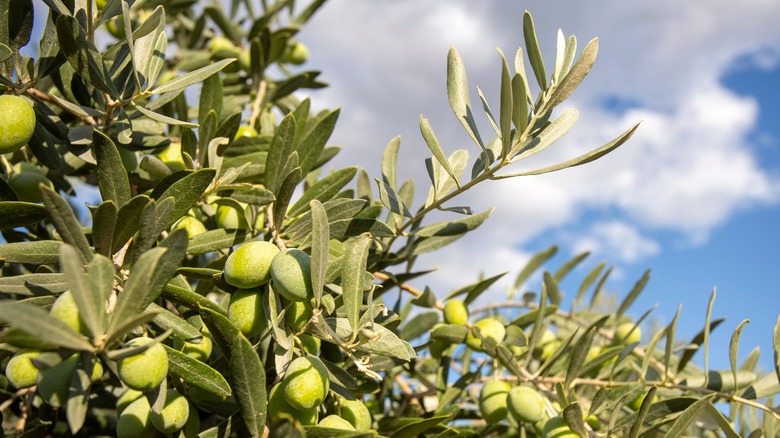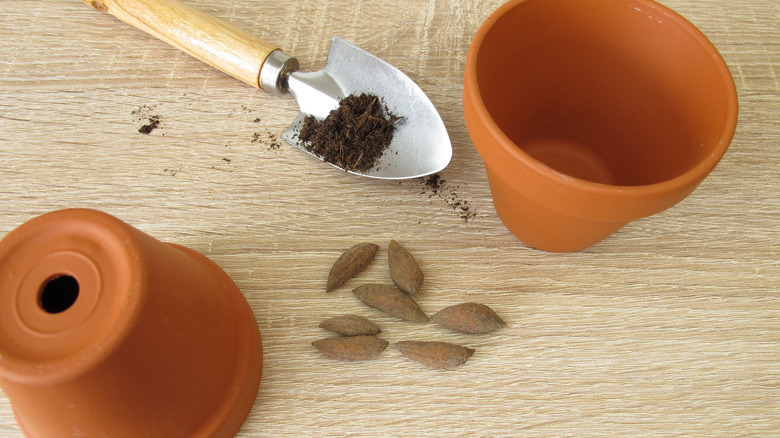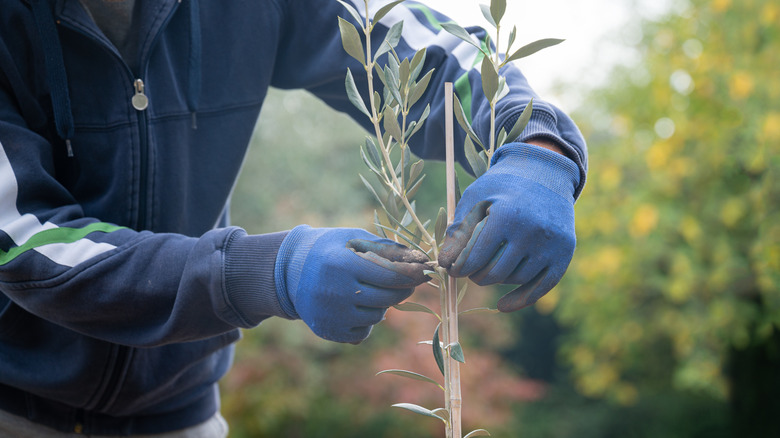How To Choose An Olive Pit For The Best Chance Of Growing A Successful Tree
You may have heard of growing avocados from a pit, but they're not the only green fruit you can propagate on your kitchen counter. Those who enjoy Mediterranean cuisine can appreciate the savory, versatile profile of the humble olive, which packs a flavorful punch despite its small size. Bite into an olive and you come across the same obstacle found in peaches and mangos— the pit. More than an obstacle, the pit is your one-way ticket to growing a beautiful olive tree (Olea europaea). Not every pit is suitable for the job, however.
If your olives hail from a shelf at the grocery store, they won't become anything other than a delicious addition to your meal. Only fresh, untreated pits will yield results when planted, but since most olives are treated with lye and salt water to negate the fruit's natural bitter taste and preserve the flesh, you might have to go out of your way to find the perfect pit. Olives are typically harvested in autumn, so this is the perfect time to contact an olive grower or head down to your local Mediterranean or Middle Eastern market to pick up a case of them. Olives harvested early in the season are the familiar green, but the late season produces fully ripened black olives, so make sure you get your olives early, as black olive pits are not as viable as green ones. Collect the pits from the olives, and you can start growing your own Mediterranean garden.
Growing an olive tree from a pit
Not all seeds sprout, whether you're dealing with cucumbers or olives, so it's best to hedge your bets. To ensure at least one produces a shoot, collect as many pits as you can. Take your saved pits and wash them with water, gently scrubbing away any bits of flesh. After they're dry, nick the outer shell of each pit with a knife to encourage germination. Soak the pits in water for one to two days, then plant them in individual pots filled with a mix of well-draining sand and seed compost or a premium cactus soil mix, pushing the pit around 1 inch deep. Keep the soil moist but not soaked, placing the pot somewhere warm. Your windowsill might not catch the Mediterranean sun, but it will have to do.
As you wait for a sprout to appear, monitor the top layer of soil, making sure it doesn't dry out fully. Most of all, don't lose hope. While a green shoot might appear after a couple weeks, it can take months to see progress, so don't get discouraged if the process is taking longer than you first thought. Once you do see a spot of green, you can start to grow your olive tree indoors, keeping it as a houseplant forever or just temporarily as you wait for the right outdoor planting conditions. Olives can grow outdoors in USDA Hardiness Zones 8 to 10; in other zones, they must be grown indoors or brought inside for the winter.
Keeping your olive tree happy
Growing and caring for olive trees is simple, but your new olive plant will need some time to establish itself before it can be called a tree. As a sapling, it might need support from a wooden post — or repurposed chopstick — to remain upright. Once it reaches at least 8 inches tall, it can be gradually acclimated to the outdoors and planted outside, ideally in the spring after the last frost. Since olives are native to the Mediterranean, they require a minimum of six hours of direct sunlight and are drought-tolerant, meaning your indoor air conditioning won't dry them out if you choose to keep yours indoors. But don't forget to water them two or three times per week in their spring growing season.
Pruning is also an important part of caring for fruit trees, which includes olive trees. As an indoor plant, an olive tree can be grown and pruned as a compact bonsai, and as an outdoor fruiting tree, it should be pruned to ensure all its leaves receive sunlight, making for a better harvest. Regular pruning also trains the tree to grow in an optimum shape, preparing it for olive production. Keep in mind that your olive tree may not produce fruit for about five years, especially since you're starting from a seed, and the resulting olives will be different from the original olive you got the pit from. Indoor trees often do not produce fruit at all.


